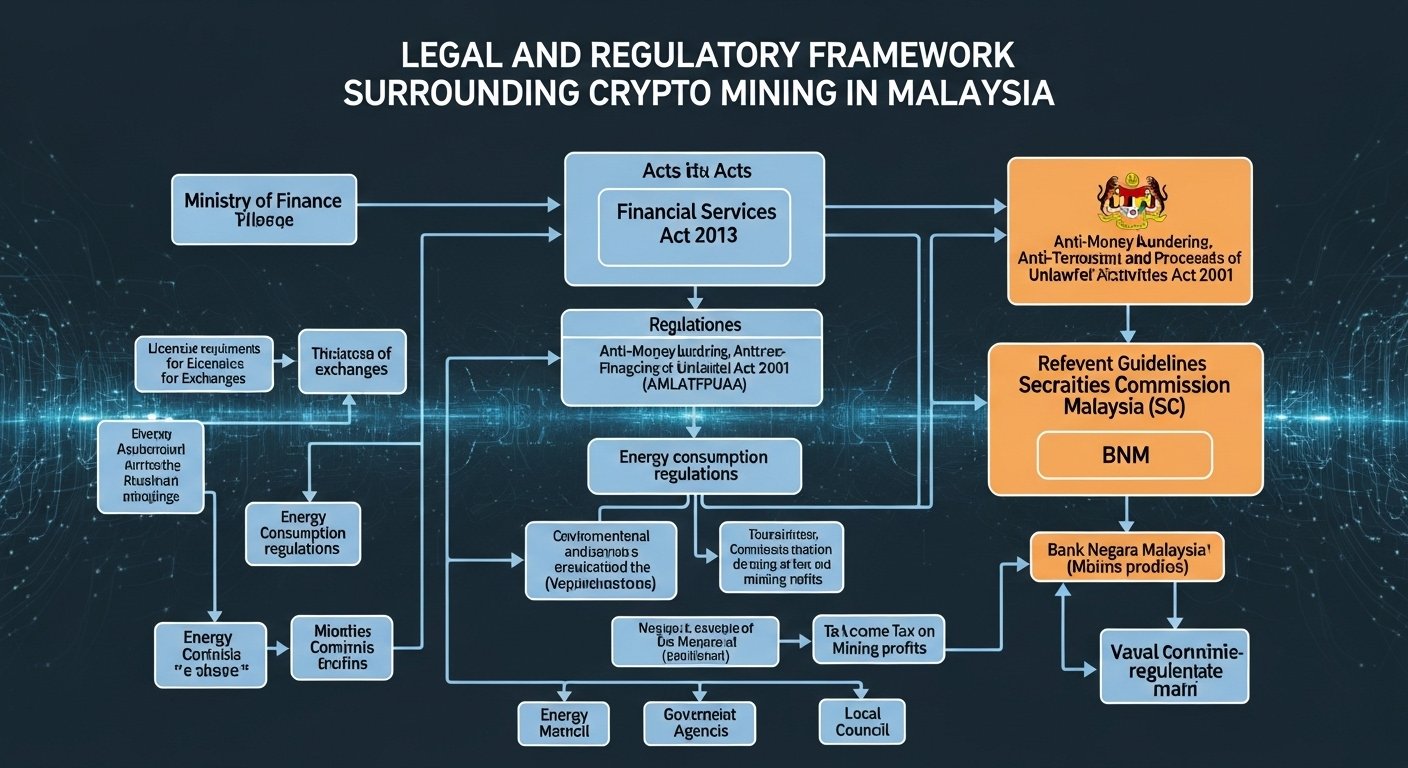
Electricity theft, primarily attributed to illegal cryptocurrency mining operations. This revelation has sent shockwaves through the country’s energy sector and raised serious concerns about the sustainability of the nation’s power infrastructure. As digital currencies continue to gain popularity worldwide, the hidden costs of crypto mining are becoming increasingly apparent, particularly in developing nations where energy subsidies and enforcement challenges create opportunities for exploitation.
The scale of these losses represents far more than just missing revenue for Malaysia’s primary utility company. It reflects a systemic challenge that threatens to undermine the country’s energy security, strain its electrical grid infrastructure, and ultimately burden honest consumers with higher electricity costs. Understanding the full scope of this crisis requires examining not only the mechanics of how cryptocurrency mining drains power resources but also the broader implications for Malaysia’s economic development and technological future.
The Scale of Electricity Theft from Cryptocurrency Mining
The $1.1 billion figure represents accumulated losses over recent years, with the problem escalating dramatically as cryptocurrency values have fluctuated and mining operations have become more sophisticated. TNB’s network, which serves approximately 9.5 million customers across Peninsular Malaysia and Sabah, has identified thousands of illegal connections and tampered meters directly linked to mining activities.
Cryptocurrency mining, particularly Bitcoin and Ethereum mining before it transitioned to proof-of-stake, requires enormous amounts of computational power. Mining rigs operate continuously, consuming electricity at rates that can match or exceed small industrial facilities. A single mining operation with multiple high-performance graphics processing units can consume as much electricity as dozens of typical households combined. When multiplied across thousands of illegal operations throughout Malaysia, the cumulative impact becomes astronomical.
What makes this situation particularly challenging is the sophistication with which these operations bypass legitimate metering systems. Some operators have tampered with smart meters, while others have created entirely unauthorized connections to the power grid. These illegal mining operations often operate in warehouses, residential properties, and commercial spaces that appear legitimate on the surface but conceal extensive mining infrastructure within.
How Crypto Mining Operations Exploit Malaysia’s Power Grid
The methodology behind electricity theft for cryptocurrency mining varies in complexity and audacity. At the most basic level, some operators simply bypass their electricity meters entirely, creating direct connections to power lines that allow them to draw unlimited electricity without triggering billing systems. More sophisticated operations involve meter tampering, where the devices are modified to underreport actual consumption, sometimes by as much as 90 percent.
Malaysia’s subsidized electricity rates have made the country an attractive location for both legitimate and illegitimate mining operations. While residential consumers enjoy some of the lowest electricity prices in Southeast Asia, industrial rates remain competitive compared to regional alternatives. This pricing structure, intended to support Malaysian citizens and businesses, has inadvertently created an arbitrage opportunity for those willing to operate outside legal frameworks.
The technical demands of cryptocurrency mining mean that operations require not just large quantities of electricity but also stable, consistent power delivery. Miners often seek locations near major power distribution points where they can tap into higher-capacity lines without causing immediate voltage drops that might alert authorities. Industrial areas, older residential neighborhoods with less sophisticated metering infrastructure, and rural locations with limited monitoring have all become hotspots for these illegal activities.
The Impact on Malaysia’s National Power Infrastructure
Beyond the direct financial losses to TNB, illegal crypto mining activities create cascading problems throughout Malaysia’s electrical grid. Unmetered and unreported power consumption makes accurate demand forecasting extremely difficult, potentially leading to capacity planning errors that could result in brownouts or blackouts. When grid operators cannot accurately predict load requirements, they must maintain larger reserve margins, which increases operational costs that ultimately get passed to legitimate consumers.
The physical strain on electrical infrastructure represents another serious concern. Transformers, distribution lines, and substations designed to serve specific neighborhoods or commercial areas suddenly face loads far exceeding their intended capacity. This overloading accelerates equipment degradation, increases maintenance requirements, and raises the risk of equipment failures that could leave entire communities without power. Several instances of transformer explosions and cable fires have been directly attributed to the excessive loads created by illegal cryptocurrency mining operations.
From a grid stability perspective, the sudden appearance and disappearance of massive loads creates additional challenges. Mining operations may power up or down based on cryptocurrency price fluctuations or regulatory enforcement actions, creating unpredictable demand spikes that complicate real-time grid management. This instability can affect power quality for all users on the same distribution circuits, potentially damaging sensitive equipment in legitimate businesses and homes.
TNB’s Response and Enforcement Challenges
Tenaga Nasional Berhad has implemented increasingly aggressive measures to combat electricity theft related to cryptocurrency mining. The utility has established specialized task forces that combine technical expertise with law enforcement capabilities to identify and shut down illegal operations. These teams utilize advanced analytics, examining consumption patterns and anomalies that might indicate tampering or theft.
The enforcement approach typically involves both technological and physical interventions. TNB officials conduct regular inspections in areas identified as high-risk based on data analysis. When illegal mining operations are discovered, authorities not only disconnect the unauthorized power supply but also confiscate mining equipment and pursue legal action against the operators. In some high-profile cases, seized mining rigs have been publicly destroyed as a deterrent to others considering similar activities.
However, the enforcement challenge remains substantial. Malaysia’s geography, with its mix of urban density and rural expanses, makes comprehensive monitoring difficult. Limited resources mean that enforcement teams must prioritize their efforts, potentially allowing smaller operations to continue undetected. Additionally, the profitability of mining during cryptocurrency price surges creates strong financial incentives for operators to take the risk of illegal connections, even accounting for the possibility of prosecution.
Legal and Regulatory Framework Surrounding Crypto Mining in Malaysia
Malaysia’s legal framework regarding cryptocurrency mining exists in a somewhat gray area that complicates enforcement efforts. While cryptocurrency trading and mining are not explicitly illegal, electricity theft unquestionably violates multiple laws, including provisions of the Electricity Supply Act 1990. Penalties for electricity theft can include substantial fines and imprisonment, with maximum sentences reaching three years for serious violations.
The challenge lies in proving intent and establishing jurisdiction. Property owners may claim ignorance of illegal mining activities conducted by tenants, while operators caught in enforcement actions sometimes argue that metering errors rather than intentional theft caused the discrepancies. These legal complexities can delay prosecutions and reduce the deterrent effect of enforcement actions.
Regulatory authorities are working to clarify the legal status of cryptocurrency mining operations and establish clearer guidelines for legitimate mining businesses. Some proposals include requiring mining operations to register with authorities, mandating specific metering and reporting requirements, and potentially creating special electricity rates for commercial mining activities. These regulatory developments aim to distinguish between legal commercial mining and illegal operations that evade payment for their massive energy consumption.
The Broader Economic Implications for Malaysian Consumers
The financial impact of electricity theft extends far beyond TNB’s balance sheet. When the utility cannot recover costs from illegal consumers, those losses must be absorbed somewhere within the system. Ultimately, this means that law-abiding electricity customers effectively subsidize the criminal activities of illegal miners through higher rates than would otherwise be necessary.
Malaysia’s electricity pricing structure already involves complex cross-subsidies between different consumer classes, with residential users paying lower rates subsidized by industrial and commercial customers. The additional burden of unrecovered losses from theft further distorts this system and may necessitate rate adjustments that particularly affect middle-income consumers who don’t qualify for the lowest residential rate tiers but lack the negotiating power of large industrial users.
From a macroeconomic perspective, the resources diverted to combating electricity theft represent an opportunity cost. The funds TNB spends on enforcement task forces, upgraded metering infrastructure, and legal proceedings could otherwise be invested in grid modernization, renewable energy integration, or expanded service to underserved areas. Similarly, the government resources devoted to prosecuting electricity theft cases could be allocated to other pressing public needs.
Global Context: Comparing Malaysia’s Situation to International Trends
Malaysia’s struggle with cryptocurrency-related electricity theft is not unique, though the scale of losses relative to the country’s economic size is noteworthy. Countries from Iran to Venezuela to various Chinese provinces have grappled with similar challenges, particularly in regions where electricity subsidies or weak enforcement create opportunities for exploitation.
Iran, for instance, has experienced such severe electricity shortages partly attributable to cryptocurrency mining that the government has periodically banned the practice entirely. In some cases, state-owned power plants have been found hosting mining operations, blurring the lines between legitimate industrial usage and corrupt diversion of subsidized energy. Venezuela’s virtually free electricity, a consequence of severe economic dysfunction, attracted international mining operations until government crackdowns and service reliability issues made it less attractive.
China’s approach has evolved dramatically, moving from tolerance of mining operations concentrated in provinces with cheap hydroelectric power to comprehensive bans that drove many miners to relocate to countries like Kazakhstan and the United States. This regulatory shift demonstrates how governments increasingly view energy-intensive crypto mining as a policy concern that must be balanced against other economic and environmental priorities.
Technological Solutions and Smart Grid Implementation
Addressing the electricity theft problem requires not just enhanced enforcement but also technological upgrades to Malaysia’s power distribution infrastructure. Smart metering technology offers significantly improved detection capabilities compared to traditional analog meters. These advanced systems provide real-time consumption data, immediately flagging anomalies that might indicate tampering or unauthorized usage.
TNB has accelerated its smart meter deployment as part of a broader grid modernization initiative. These meters incorporate tamper-detection features that alert operators to physical interference or unusual magnetic fields that might indicate bypass attempts. Additionally, the granular data from smart meters enables sophisticated analytics that can identify consumption patterns characteristic of cryptocurrency mining, even when operators attempt to conceal their activities.
Beyond metering, advanced grid monitoring systems can detect unusual loads at the circuit level, identifying locations where actual power draw exceeds metered consumption. These systems use a combination of sensors throughout the distribution network and artificial intelligence algorithms to spot discrepancies that warrant investigation. While these technological solutions require substantial upfront investment, they promise to pay dividends through reduced theft and improved operational efficiency.
The Environmental Dimension of Cryptocurrency Mining
The environmental implications of cryptocurrency mining add another layer to the concerns surrounding illegal operations in Malaysia. The electricity consumed by these activities, whether paid for legitimately or stolen, must be generated somewhere. In Malaysia, where the power mix remains heavily dependent on fossil fuels, particularly natural gas and coal, the massive energy consumption translates directly into carbon emissions and air pollution.
Estimates suggest that Bitcoin mining globally consumes more electricity annually than many medium-sized countries. When this mining occurs through stolen electricity, the environmental damage happens without even the economic benefit of paid generation and transmission. The carbon footprint of illegal cryptocurrency mining in Malaysia contributes to the country’s overall emissions profile and works against efforts to meet international climate commitments under the Paris Agreement.
Some argue that the future of cryptocurrency lies in more energy-efficient consensus mechanisms, such as proof-of-stake systems that require far less computational power than traditional proof-of-work mining. However, Bitcoin and other major cryptocurrencies continue to rely on energy-intensive mining, ensuring that the electricity demands and associated environmental concerns will persist for the foreseeable future.
Looking Forward: Sustainable Approaches to Cryptocurrency Mining
Despite the challenges, cryptocurrency mining need not be inherently problematic if conducted within proper legal and economic frameworks. Some countries have developed models for legitimate mining industries that contribute to local economies while operating transparently within regulatory structures. The key lies in ensuring that miners pay market rates for electricity, comply with environmental regulations, and contribute to rather than drain from national infrastructure.
Malaysia could potentially develop its own framework for legitimate crypto mining operations that takes advantage of the country’s technological capabilities and strategic location. Such operations might utilize renewable energy sources, operate in designated zones with appropriate industrial infrastructure, and pay premium electricity rates that reflect the true cost of power generation and distribution. This approach would capture economic benefits from the cryptocurrency industry while preventing the exploitation that has led to the current crisis.
Educational initiatives also play a role in addressing the problem. Many property owners unknowingly lease space to illegal mining operations, unaware of the legal risks they face. Raising awareness about the signs of illegal mining activity and the consequences of participating in or facilitating electricity theft can help reduce the availability of locations for these operations.
Conclusion
The $1.1 billion in electricity losses that Malaysia’s TNB network has suffered due to cryptocurrency mining represents a wake-up call for policymakers, utility operators, and citizens alike. This crisis illustrates how emerging technologies can create unintended consequences when regulatory frameworks lag behind innovation and when enforcement capabilities fail to keep pace with sophisticated criminal enterprises.
Addressing this challenge requires a multifaceted approach combining technological upgrades, enhanced enforcement, clearer regulations, and public awareness. Smart grid infrastructure and advanced metering systems provide the tools to detect and prevent theft, while stronger legal frameworks and consistent prosecution create deterrents. Meanwhile, developing pathways for legitimate cryptocurrency mining operations could channel entrepreneurial energy into productive economic activity rather than criminal exploitation.
The stakes extend beyond financial losses to TNB. At issue is the integrity of Malaysia’s power infrastructure, the fairness of electricity pricing for honest consumers, and the country’s ability to manage its energy resources in support of sustainable economic development. Successfully navigating this challenge will require sustained commitment from government agencies, utility operators, technology providers, and the broader Malaysian society to protect this critical national resource while embracing the opportunities that digital innovation can offer when properly channeled.
FAQs
Q: Why is Malaysia particularly vulnerable to electricity theft for cryptocurrency mining?
Malaysia’s combination of subsidized electricity rates, relatively developed power infrastructure, and enforcement challenges creates an attractive environment for illegal mining operations. The country offers some of Southeast Asia’s lowest residential electricity prices while maintaining reliable power delivery, making it economically attractive for miners.
Q: How does TNB detect illegal cryptocurrency mining operations?
TNB employs multiple detection methods, including advanced data analytics that identify unusual consumption patterns, physical inspections of suspicious premises, thermal imaging to detect heat signatures from mining equipment, and smart meter technology that reports tampering attempts.
Q: What are the legal consequences for individuals caught stealing electricity for crypto mining?
Under Malaysia’s Electricity Supply Act 1990, electricity theft carries serious penalties, including fines up to RM100,000 and imprisonment for up to three years for individual offenses. Repeat offenders face enhanced penalties, and authorities can also confiscate mining equipment used in illegal operations.
Q: Can cryptocurrency mining ever be conducted legally in Malaysia?
Yes, cryptocurrency mining itself is legal in Malaysia when conducted properly. Legitimate operations must pay for all electricity consumed at appropriate rates, comply with all relevant regulations, and operate transparently. However, the profitability of legal mining is significantly lower than illegal operations that steal electricity.
Q: How do illegal mining operations affect regular electricity consumers in Malaysia?
Illegal mining operations impact regular consumers in several ways. First, the unrecovered losses from electricity theft contribute to higher rates for paying customers who effectively subsidize the illegal activity. Second, the excessive loads from illegal operations can degrade power quality and reliability in affected areas.









